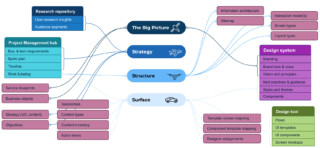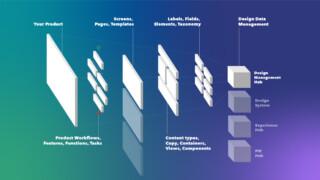Unlocking UX Success
The Power of Knowledge Management
by Maria Taylor

As we aim for success in 2024, we’re confronted with several key challenges that have emerged in recent years, challenges that still sit directly in our path ahead.
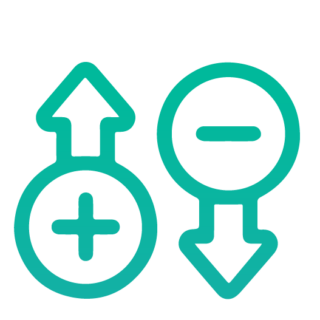
Doing more with less
Many of us are dealing with increasing budget, resource, and time restrictions. Those increasing restrictions require team members to stretch and cover more work items with inflexible deadlines.
Improving collaboration and communication
The sustained shift to remote work since the height of the pandemic underscores the need for improving digital collaboration and communication within and across teams. UXers and everyone else are striving to find better ways to engage with vertically and horizontally integrated collaborators.
Scaling research and design
Design systems get us part of the way there. However, there is room to continue scaling research and design processes, tools, and artifacts to help us commoditize where possible. These advancements will allow teams to focus on more complex challenges and opportunities.
Increasing transparency and accountability
More must be done to align business values and metrics further. More work is also required to demystify UX and provide mechanisms for non-design collaborators to see and understand UX's contribution and impact on the bottom line.
Democratization of research and design
We must balance cultivating awareness and involvement among roles without deep technical UX expertise and securing highly skilled UX resources that can do the work, elevate their craft, and drive innovation.
Adopting AI and automation
UX professionals are starting to leverage AI within our core skill areas (e.g., what tasks will be replaced by AI, what tasks will be augmented by AI, and what new tasks must be added to UXers' skillset because of AI). In hopes of reducing costs, many organizations are reducing team sizes based on unproven expectations of AI before doing the necessary work to understand AI's actual impact and how to use it to build a competitive advantage.
“In a recent study on workplace knowledge and productivity by Panopto, across 1,001 respondents, 60% found it difficult, very difficult, or nearly impossible to get the information they needed to do their jobs well.” – Source: Panopto.com
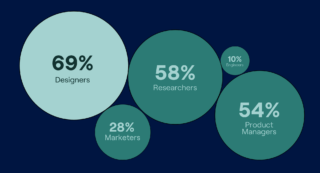
“In a Maze report on continuous research trends, 64% of participants reported that their organizations have a democratized research culture.
According to the audience surveyed, in addition to researchers, designers (69%), product managers (54%), marketers (28%), and engineers (10%) conduct research at their companies.” – Source: Maze.co
Adaptation & Evolution
These challenges all share a common theme of adaptation and evolution in the field of user experience. As we address these challenges, we must look for solutions that propel the field forward to new levels of excellence. Addressing user experience knowledge management is key to overcoming those challenges.
Harnessing UX knowledge
Here is a story that better explains the connection between these challenges and how knowledge management can help.

You are a Senior UI Designer who just started a new job. To help you get up and running as quickly as possible, you need to know more about the company, the product you will be working on, and the people you will be working with:
- Is there an intranet I can use to get up to speed on the company?
- What does my tool stack look like?
- What design changes have been implemented over the last year?
- How much of the UI library is connected to the design system?
- Who is on my team, and what are their skill sets?
- Are there any communities I can join to start building my network?
- I was hired as a designer, but I need to partner with non-UX team members to run user testing; is there a standard usability testing playbook?
As a designer, you need access to a mix of organizational, team, and role-specific information, some of which should be well-documented, and some can only come from finding the right people to talk to and learn from.
The information this Senior UI Designer seeks are all examples of organizational knowledge that will enable them to address the challenges of straddling multiple skills and supporting and collaborating with non-UXers to achieve positive and measurable outcomes. They must be able to do all of this while learning the organization’s culture and how to communicate and collaborate successfully. Better knowledge management is not the only solution. But if we are looking for significant actions that can make a meaningful impact on alleviating these pain points, this is an area where we can and should do more.
This example focuses on a designer transitioning into a new company and position. However, most of their information needs are not unique to starting a new job, and they will continue to struggle with these challenges and the ability to address these needs throughout their career until there is a solution.
Embracing the role of knowledge stewardship
The need for DesignOps as a function is gaining traction in many organizations seeking to better enable design excellence in this shifting landscape. Managing UX knowledge is core to that function and to meeting the needs of our time.
“We talk about templates, playbooks, design systems, and insight repositories, but they are only part of a larger UX knowledge management solution that must be developed.” – Maria Taylor
To help our profession weather the current storm and continue to enable excellence, we need to build a more comprehensive understanding of UX knowledge management and fully embrace the responsibility of knowledge stewardship.
This responsibility starts with you if you have a DesignOps title or responsibilities. If your organization still needs DesignOps, these responsibilities lie with whoever is in charge of improving the efficiency and effectiveness of researchers and designers.
To help us understand where to get started, we need to define knowledge and clarify what types of knowledge need to be managed, as different types of knowledge require different processes, tools, and systems to support them.
Types of knowledge
As we dig in, let’s start at the ground floor and level set on what knowledge is and isn’t.
According to the Oxford Languages Dictionary, Knowledge is
“Facts, information, and skills acquired by a person through experience or education; the theoretical or practical understanding of a subject.”
So, knowledge isn’t just about the facts and information you know; it’s about the skills you have and the understanding you build.
There are multiple types of knowledge. We focus on three types: explicit, implicit, and tacit knowledge.
Knowledge: “ n. Facts, information, and skills acquired by a person through experience or education; the theoretical or practical understanding of a subject.” -Source: Oxford Languages Dictionary
Explicit knowledge
Explicit knowledge is knowledge expressed in words, numbers, and symbols; in other words, it can be written down and stored. User experience-related examples of explicit knowledge include playbooks, research reports, design processes, and how-to guides. It also includes the information stored in a design system or a research insight repository.
Tacit knowledge
Tacit knowledge refers to skills, abilities, and know-how gained through experience. Examples include instincts, attitudes, and mental models. Some academics identify a third type called "Implicit knowledge," which is essentially tacit knowledge that can be documented more easily. For simplicity, I'll include implicit knowledge within tacit knowledge and address both explicit and tacit knowledge equally in this article.
Institutional Knowledge
Explicit knowledge represents only 20% of institutional knowledge; the remaining 80% is tacit knowledge.

According to Wang and Yang in their article, Empirical Study of Employees’ Tacit Knowledge Sharing Behavior, Many researchers think that tacit knowledge is the foundation for building a sustainable competitive advantage. And, since the bulk of institutional knowledge is tacit, we must find ways to share it and, at least, partially document it.
Knowledge management
Typically, organizational knowledge is managed through a universe of repositories and software solutions. Below is a diagram depicting a set of knowledge repositories you can commonly find within somewhat mature to mature organizations.
Explicit Knowledge Repositories
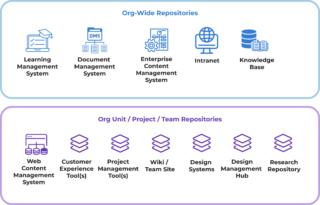
“Knowledge management is the process of identifying, organizing, storing and disseminating information within an organization.” – IBM
Standard organization-wide repositories include learning management systems, document and content management systems, corporate intranets, and knowledge bases. In addition, repositories are typically owned or used by specific parts of the organization. For example, marketing may manage a web content management system as the backbone of the corporate website.
Tacit (implicit) Knowledge Repositories
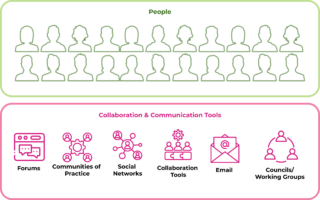
Since most tacit knowledge resides within people’s heads, individual people are tacit knowledge repositories, each with their own unique set of information. Increasing tacit knowledge sharing is done by creating places where people meet and share.
Tacit knowledge is primarily shared in informal channels like discussions with colleagues, mentorship programs, team meetings, and workplace social events to learn and exchange tacit institutional knowledge. These avenues offer opportunities for sharing insights, experiences, and practical know-how not necessarily documented. Additionally, online forums, networking platforms, and industry conferences extend opportunities for tacit knowledge exchange beyond the workplace.
It is up to DesignOps team members to determine how UX KM fits into this universe of information. This involves curating the various types of UX knowledge and identifying whether they need new repositories or if repositories already in use can be modified to serve UX knowledge needs.
“A complete KM Solution must support tacit and explicit knowledge sharing.” – Maria Taylor
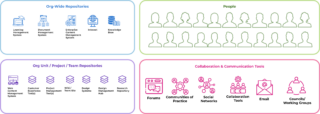
Remember that UXers are not the only ones who need access to UX knowledge. Other individuals and groups also participating in UX processes need access to the same information. There needs to be UX knowledge packaged up for everyone from the C-Suite down to the stakeholders who collaborate with designers and researchers or make decisions about their work.
Unlocking organizational performance
At this point, you may be wondering how you will get buy-in to tackle knowledge management as a solution to addressing the challenges described at the beginning of this blog. Thankfully, it is well-documented that knowledge management is a critical component in elevating organizational performance.
Why? Because effective knowledge management significantly contributes to:
- Driving innovation
- Increasing productivity
- Increasing efficiency and effectiveness
- Supporting better and faster decision-making and problem-solving
- Improving collaboration and communication
- Facilitating a culture of continuous learning
- Supporting quicker reaction to changing dynamics
- Preserving expertise within the organization
- Driving innovation
- Increasing productivity
- Increasing efficiency and effectiveness
- Supporting better and faster decision-making and problem-solving
- Improving collaboration and communication
- Facilitating a culture of continuous learning
- Supporting quicker reaction to changing dynamics
- Preserving expertise within the organization
And these factors have a measurable impact on the bottom line.

If we look at these outcomes, we can see a direct alignment between the challenges we need to address and a practice with a proven track record of producing positive results in the face of these challenges.
Stay Tuned
This article is the first in a series of articles exploring UX knowledge management. The following articles will discuss best practices for organizing the people, processes, tools, and artifacts necessary for success while addressing organizational context and exploring methods for activating transformative outcomes.
Interested in how Limina manages UX knowledge?
Read our design planning and management whitepaper that outlines various types of design information organizations struggle to continuously integrate for delivering research and design at scale. Our model allows digital product teams to better organize and integrate research and design into continuous integration product lifecycles.
Want to get a UX KM kick-start?
Introducing the Design Management (DM) Kick-start, an information management framework to scale your design operations. Check out how we lower context switching by consolidating, organizing, and managing design data for planning, management, and execution of design.
